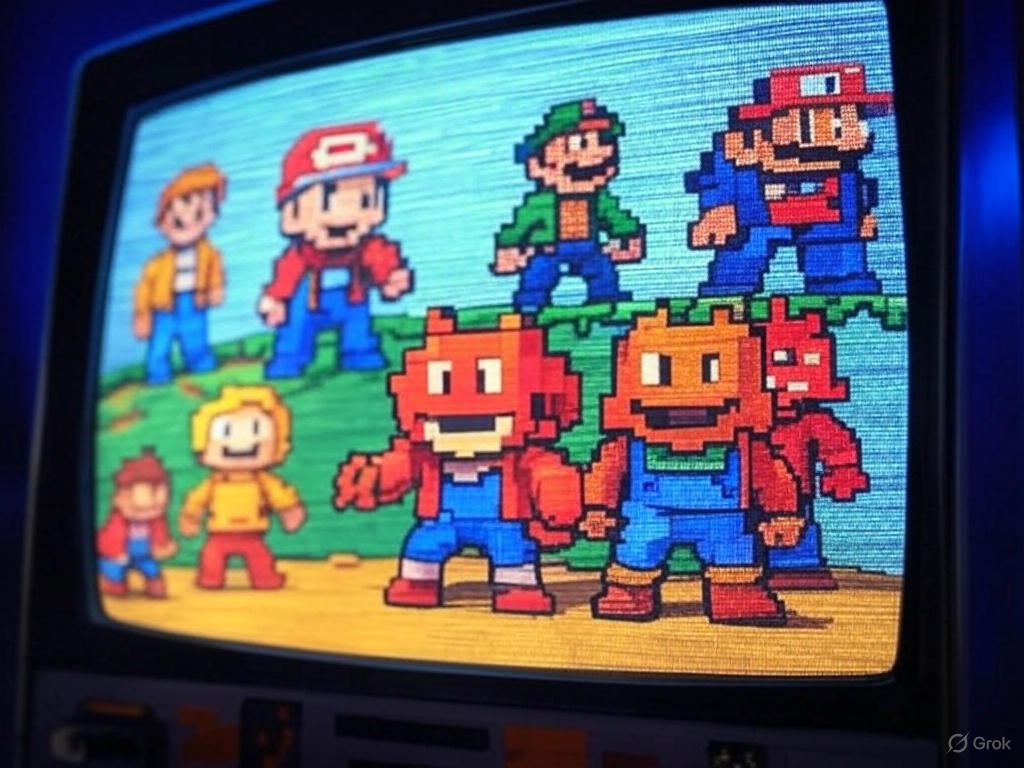Digital Art in Gaming: Blurring the Line Between Art and Entertainment
The world of video games has evolved far beyond its origins as simple pixelated distractions. Today, games are immersive experiences that rival films, novels, and traditional visual arts in their ability to captivate and inspire. At the heart of this transformation lies digital art, a medium that has not only shaped the aesthetic of gaming but also redefined the boundaries between art and entertainment. From retro 8-bit sprites to photorealistic open worlds, digital art in gaming has become a cultural force, blending technical innovation with creative storytelling to create experiences that resonate deeply with players.
The Roots of Digital Art in Gaming
The earliest video games, like Pong (1972) and Space Invaders (1978), relied on rudimentary graphics due to hardware limitations. These games used simple shapes and blocky pixels, yet their charm lay in their minimalist creativity. Artists worked within tight constraints—often limited to a handful of colors and low-resolution displays—to craft iconic visuals that remain nostalgic touchstones today. This era of pixel art was less about realism and more about suggestion, where a few well-placed pixels could evoke a spaceship or a menacing alien.
As technology advanced in the 1980s and 1990s, so did the scope of digital art in games. The introduction of 16-bit consoles like the Super Nintendo and Sega Genesis allowed for more detailed sprites, vibrant color palettes, and early experiments with parallax scrolling, which gave backgrounds a sense of depth. Games like The Legend of Zelda: A Link to the Past (1991) showcased how digital art could enhance storytelling, with lush, hand-drawn environments that felt alive despite their two-dimensional nature. These advancements marked the beginning of gaming as a visual art form, where aesthetics were as crucial as gameplay.
The 3D Revolution and Artistic Ambition
The mid-1990s brought a seismic shift with the advent of 3D graphics, pioneered by consoles like the Sony PlayStation and Nintendo 64. Games such as Final Fantasy VII (1997) and The Legend of Ocarina of Time (1998) introduced polygonal models, textured surfaces, and cinematic cutscenes, expanding the artistic possibilities of gaming. Digital artists now faced the challenge of creating cohesive 3D worlds, requiring skills in modeling, texturing, and lighting. These games demonstrated that digital art could evoke emotional depth, with sprawling landscapes and expressive character designs that rivaled traditional media.
This era also saw the rise of concept art as a critical component of game development. Artists sketched fantastical worlds and characters to guide developers, bridging the gap between imagination and technical execution. For instance, the dystopian cityscapes of Half-Life 2 (2004) were born from concept art that blended realism with surrealism, creating immersive environments that felt both familiar and alien. Digital art in gaming was no longer just about visuals; it was about world-building, where every texture, lighting effect, and architectural detail contributed to a narrative.
Modern Gaming: A Canvas for Digital Art
Today, digital art in gaming has reached unprecedented heights, driven by powerful hardware and sophisticated software. Games like The Last of Us Part II (2020) and Red Dead Redemption 2 (2018) achieve photorealistic visuals, with lifelike character animations and dynamic environments that respond to player actions. These titles showcase how digital artists use advanced techniques—such as motion capture, procedural generation, and ray tracing—to create worlds that blur the line between reality and fiction. The attention to detail in these games, from the rust on a abandoned car to the swaying of grass in the wind, elevates them to the status of interactive art.
Yet, realism is only one facet of digital art in gaming. Indie games like Hollow Knight (2017) and Cuphead (2017) embrace stylized aesthetics, drawing inspiration from hand-drawn animation and retro cartoons. Cuphead, for example, meticulously recreates the look of 1930s Fleischer cartoons, with every frame hand-painted by artists. This resurgence of pixel art and stylized visuals proves that digital art in gaming thrives on diversity, where artistic vision often outweighs technical prowess. These games challenge the notion that cutting-edge graphics are necessary for artistic impact, prioritizing creativity over realism.
The Role of Digital Art in Storytelling
Digital art in gaming does more than create pretty pictures; it serves as a storytelling tool that immerses players in narrative worlds. Environments, character designs, and even user interfaces are crafted to convey mood, culture, and history. In Journey (2012), the minimalist art style—featuring flowing sand dunes and vibrant silks—evokes a sense of wonder and solitude, guiding players through an emotional pilgrimage without words. Similarly, Bloodborne (2015) uses gothic architecture and grotesque creature designs to instill dread, immersing players in a nightmarish universe.
Lighting and color palettes also play a pivotal role. In Cyberpunk 2077 (2020), neon-soaked cityscapes contrast with desolate wastelands, reflecting the game’s themes of corporate excess and human struggle. Digital artists carefully balance these elements to guide player emotions, making environments as integral to the story as dialogue or plot. This synergy between art and narrative transforms games into interactive artworks, where players actively participate in the creative vision.
Cultural and Social Impact
The influence of digital art in gaming extends beyond the screen, shaping broader cultural trends. Game aesthetics have inspired fashion, music, and even traditional art, with cyberpunk and retro-futurist styles gaining mainstream popularity. Exhibitions like the Smithsonian’s The Art of Video Games (2012) have recognized games as a legitimate art form, showcasing concept art and in-game visuals alongside traditional paintings and sculptures. Digital art from games has also found a home in fan communities, where artists create fan art, mods, and animations inspired by their favorite titles.
Moreover, gaming has democratized art creation. Tools like Unreal Engine and Unity allow aspiring artists to craft their own games, lowering barriers to entry. Platforms like itch.io and Steam provide spaces for indie developers to share their work, fostering a vibrant ecosystem of experimental art games. Titles like Gris (2018), with its watercolor-inspired visuals, demonstrate how small teams can create profound artistic experiences, challenging the dominance of big-budget studios.
The Future of Digital Art in Gaming
As technology continues to evolve, so will the role of digital art in gaming. Virtual reality (VR) and augmented reality (AR) are pushing boundaries, enabling artists to create fully immersive worlds that players can inhabit. Games like Half-Life: Alyx (2020) showcase VR’s potential, with tactile environments that feel tangible. Meanwhile, AI-driven tools are streamlining art production, allowing artists to generate textures or animations more efficiently, though debates persist about AI’s impact on artistic authenticity.
The line between art and entertainment in gaming will likely blur further as developers experiment with interactive storytelling and player-driven narratives. Procedural art generation, where algorithms create unique visuals in real-time, could lead to infinitely varied game worlds. Additionally, the integration of blockchain technology and digital collectibles may redefine how art is owned and shared within games, though environmental concerns about energy consumption remain a challenge.
Conclusion
Digital art in gaming has transformed a once-niche hobby into a global art form, where creativity and technology converge to create unforgettable experiences. From the pixelated charm of early arcade games to the breathtaking vistas of modern open-world epics, digital art has consistently pushed the boundaries of what games can achieve. By blending aesthetics with narrative and interactivity, games have become more than entertainment—they are canvases for human expression, inviting players to explore, feel, and create. As we look to the future, digital art will continue to shape gaming, proving that the line between art and entertainment was never truly there to begin with.
 Digital Art in Gaming: Blurring the Line Between Art and Entertainment
Digital Art in Gaming: Blurring the Line Between Art and Entertainment
 Eco-Conscious Digital Art: Sustainability in a Digital Age
Eco-Conscious Digital Art: Sustainability in a Digital Age
 The Rise of AI-Generated Art: Revolution or Controversy?
The Rise of AI-Generated Art: Revolution or Controversy?